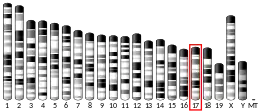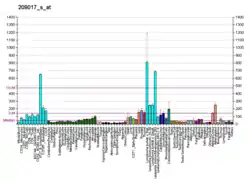LONP1
Lon protease homolog, mitochondrial is a protease, an enzyme that in humans is encoded by the LONP1 gene.[5][6][7][8]
Structure
The nuclear-gene encoded mitochondrial matrix LON peptidase 1 (LONP1), originally thought to be responsible for protein quality control (PQC) by degrading unfolded or misfolded proteins, has several essential functions like proteolytic activity, chaperone activity and mitochondrial DNA (mtDNA) regulation. Lon protease is a member of ATP-dependent proteases (AAA+ proteases). Mature LONP1 is catalytically active in its homohexameric structure, while other formations of complexes have been observed such as the homoheptameric ring in Saccharomyces cerevisiae. A single subunit of LONP1 consists of three domains: The N-domain for substrate recognition and binding, an AAA + module (A-domain) for ATP binding and hydrolysis, and a P-domain for protein proteolysis. A homologous protease to LONP1 expressed in E.coli. regulates gene expression by targeting specific regulatory proteins for degradation. Moreover, LONP1 is able to bind a specific sequence in the light and heavy chain promoters of the mitochondrial genome which are involved in regulation of mtDNA replication and transcription.[7]

Function
Lon protease (LONP1) is a conserved serine peptidase identified from bacteria to eukaryotic cells.[9] In mitochondrial matrix, a majority of damaged proteins is removed via proteolysis led by Lon protease, which is an essential mechanism for mitochondrial protein quality control. LONP1 is the major protease responsible for the recognition and removal of unfolded proteins in the mitochondrial matrix and thereby protects the cell from the accumulation of aggregated proteins in the mitochondrion.[10] However LONP1 is unable to recognise or degrade model aggregated proteins.
For Lon protease-dependent degradation, protein substrates are first recognized and then unfolded if necessary in an ATP-dependent manner. The substrates are subsequently transferred through the pore of complex and into the proteolytic chamber of complex for degradation. ATP binding to the AAA module of the Lon complex results in a change in Lon conformation into a proteolytically active state. In general, Lon protease interacts with peptide regions(sequences) that are located within the hydrophobic core of substrates and rarely on the surface. These regions can be presented to Lon protease when proteins are damaged and lost their conformation integrity.[11] In addition to misfolded proteins, several regulatory proteins can be processed by Lon protease by removing a degradable tag before they fully gain their biological functions.[12]
LONP1 is also a DNA-binding protein that participates in mtDNA maintenance and gene expression regulation.[13] LONP1 degrades mitochondrial transcription factor A (TFAM) when substrate is modified by post-translational modifications (PTMs) such as phosphorylation, regulating mtDNA copy number and metabolism to maintain the TFAM/mtDNA ratio necessary to control replication and transcription.[14]
Clinical significance and genetic deficiency
Given the crucial role of LON protease in maintaining the control of mitochondrial function,[15] its dynamics in expression under stress conditions has been found associating with human diseases and aging.[16][17] For example, LONP1 expression levels are increased in different tumors and tumor cell lines. Downregulation of LONP1 in some tumor cells causes apoptosis and cell death, indicating a possible addiction of tumor cells to LONP1 function, as occurs with other intracellular proteases associated with cancer. In addition, genetic deficiency of LONP1, caused by biallelic deleterious variants in the LONP1 gene, result in a pattern of severe congenital anomalies called the CODAS syndrome[18][19] for "Cerebral, ocular, dental, auricular, skeletal anomalies.[20] Thus, LONP1 seems to have important functions in developmental processes that had not been predicted from the previous studies in cell culture models. A study published in 2021 has suggested that genetic variants in LONP1 may be a predisposing factor to the development of congenital diaphragmatic hernia.[21] highlighting yet another role of LONP1 in human embryonic/fetal development.
See also
References
- GRCh38: Ensembl release 89: ENSG00000196365 - Ensembl, May 2017
- GRCm38: Ensembl release 89: ENSMUSG00000041168 - Ensembl, May 2017
- "Human PubMed Reference:". National Center for Biotechnology Information, U.S. National Library of Medicine.
- "Mouse PubMed Reference:". National Center for Biotechnology Information, U.S. National Library of Medicine.
- Wang N, Gottesman S, Willingham MC, Gottesman MM, Maurizi MR (December 1993). "A human mitochondrial ATP-dependent protease that is highly homologous to bacterial Lon protease". Proceedings of the National Academy of Sciences of the United States of America. 90 (23): 11247–51. Bibcode:1993PNAS...9011247W. doi:10.1073/pnas.90.23.11247. PMC 47959. PMID 8248235.
- Petukhova GV, Grigorenko VG, Lykov IP, Yarovoi SV, Lipkin VM, Gorbalenya AE (February 1994). "Cloning and sequence analysis of cDNA for a human homolog of eubacterial ATP-dependent Lon proteases". FEBS Letters. 340 (1–2): 25–8. doi:10.1016/0014-5793(94)80166-5. PMID 8119403. S2CID 23827802.
- "Entrez Gene: LONP1 lon peptidase 1, mitochondrial".
- Pinti M, Gibellini L, Liu Y, Xu S, Lu B, Cossarizza A (December 2015). "Mitochondrial Lon protease at the crossroads of oxidative stress, ageing and cancer". Cellular and Molecular Life Sciences. 72 (24): 4807–24. doi:10.1007/s00018-015-2039-3. PMID 26363553. S2CID 14668486.
- Lu B, Liu T, Crosby JA, Thomas-Wohlever J, Lee I, Suzuki CK (March 2003). "The ATP-dependent Lon protease of Mus musculus is a DNA-binding protein that is functionally conserved between yeast and mammals". Gene. 306: 45–55. doi:10.1016/s0378-1119(03)00403-7. PMID 12657466.
- Bezawork-Geleta A, Brodie EJ, Dougan DA, Truscott KN (December 2015). "LON is the master protease that protects against protein aggregation in human mitochondria through direct degradation of misfolded proteins". Scientific Reports. 5 (1): 17397. Bibcode:2015NatSR...517397B. doi:10.1038/srep17397. PMC 4667172. PMID 26627475.
- Gur E, Sauer RT (August 2008). "Recognition of misfolded proteins by Lon, a AAA(+) protease". Genes & Development. 22 (16): 2267–77. doi:10.1101/gad.1670908. PMC 2518814. PMID 18708584.
- Birghan C, Mundt E, Gorbalenya AE (January 2000). "A non-canonical lon proteinase lacking the ATPase domain employs the ser-Lys catalytic dyad to exercise broad control over the life cycle of a double-stranded RNA virus". The EMBO Journal. 19 (1): 114–23. doi:10.1093/emboj/19.1.114. PMC 1171783. PMID 10619850.
- Liu T, Lu B, Lee I, Ondrovicová G, Kutejová E, Suzuki CK (April 2004). "DNA and RNA binding by the mitochondrial lon protease is regulated by nucleotide and protein substrate". The Journal of Biological Chemistry. 279 (14): 13902–10. doi:10.1074/jbc.m309642200. PMID 14739292.
- Lu B, Lee J, Nie X, Li M, Morozov YI, Venkatesh S, Bogenhagen DF, Temiakov D, Suzuki CK (January 2013). "Phosphorylation of human TFAM in mitochondria impairs DNA binding and promotes degradation by the AAA+ Lon protease". Molecular Cell. 49 (1): 121–32. doi:10.1016/j.molcel.2012.10.023. PMC 3586414. PMID 23201127.
- Bota DA, Ngo JK, Davies KJ (March 2005). "Downregulation of the human Lon protease impairs mitochondrial structure and function and causes cell death". Free Radical Biology & Medicine. 38 (5): 665–77. doi:10.1016/j.freeradbiomed.2004.11.017. PMID 15683722. S2CID 32448357.
- Ngo JK, Pomatto LC, Davies KJ (9 February 2013). "Upregulation of the mitochondrial Lon Protease allows adaptation to acute oxidative stress but dysregulation is associated with chronic stress, disease, and aging". Redox Biology. 1: 258–64. doi:10.1016/j.redox.2013.01.015. PMC 3757690. PMID 24024159.
- Hamon MP, Bulteau AL, Friguet B (September 2015). "Mitochondrial proteases and protein quality control in ageing and longevity". Ageing Research Reviews. 23 (Pt A): 56–66. doi:10.1016/j.arr.2014.12.010. PMID 25578288. S2CID 205667759.
- Dikoglu E, Alfaiz A, Gorna M, Bertola D, Chae JH, Cho TJ, et al. (July 2015). "Mutations in LONP1, a mitochondrial matrix protease, cause CODAS syndrome". American Journal of Medical Genetics. Part A. 167 (7): 1501–9. doi:10.1002/ajmg.a.37029. PMID 25808063. S2CID 24136909.
- Strauss KA, Jinks RN, Puffenberger EG, Venkatesh S, Singh K, Cheng I, et al. (January 2015). "CODAS syndrome is associated with mutations of LONP1, encoding mitochondrial AAA+ Lon protease". American Journal of Human Genetics. 96 (1): 121–35. doi:10.1016/j.ajhg.2014.12.003. PMC 4289676. PMID 25574826.
- "MIM 600373: Codas Syndrome". OMIM.
- Qiao L, Xu L, Yu L, Wynn J, Hernan R, Zhou X, et al. (October 2021). "Rare and de novo variants in 827 congenital diaphragmatic hernia probands implicate LONP1 as candidate risk gene". American Journal of Human Genetics. 108 (10): 1964–1980. doi:10.1016/j.ajhg.2021.08.011. ISSN 0002-9297. PMC 8546037. PMID 34547244.
Further reading
- Lu B, Yadav S, Shah PG, Liu T, Tian B, Pukszta S, Villaluna N, Kutejová E, Newlon CS, Santos JH, Suzuki CK (June 2007). "Roles for the human ATP-dependent Lon protease in mitochondrial DNA maintenance". The Journal of Biological Chemistry. 282 (24): 17363–74. doi:10.1074/jbc.M611540200. PMID 17420247.
- Bota DA, Ngo JK, Davies KJ (March 2005). "Downregulation of the human Lon protease impairs mitochondrial structure and function and causes cell death". Free Radical Biology & Medicine. 38 (5): 665–77. doi:10.1016/j.freeradbiomed.2004.11.017. PMID 15683722. S2CID 32448357.
- Liu T, Lu B, Lee I, Ondrovicová G, Kutejová E, Suzuki CK (April 2004). "DNA and RNA binding by the mitochondrial lon protease is regulated by nucleotide and protein substrate". The Journal of Biological Chemistry. 279 (14): 13902–10. doi:10.1074/jbc.M309642200. PMID 14739292.
- Lu B, Liu T, Crosby JA, Thomas-Wohlever J, Lee I, Suzuki CK (March 2003). "The ATP-dependent Lon protease of Mus musculus is a DNA-binding protein that is functionally conserved between yeast and mammals". Gene. 306: 45–55. doi:10.1016/S0378-1119(03)00403-7. PMID 12657466.
- Bota DA, Davies KJ (September 2002). "Lon protease preferentially degrades oxidized mitochondrial aconitase by an ATP-stimulated mechanism" (PDF). Nature Cell Biology. 4 (9): 674–80. doi:10.1038/ncb836. PMID 12198491. S2CID 24893953.
- Hori O, Ichinoda F, Tamatani T, Yamaguchi A, Sato N, Ozawa K, Kitao Y, Miyazaki M, Harding HP, Ron D, Tohyama M, M Stern D, Ogawa S (June 2002). "Transmission of cell stress from endoplasmic reticulum to mitochondria: enhanced expression of Lon protease". The Journal of Cell Biology. 157 (7): 1151–60. doi:10.1083/jcb.200108103. PMC 2173558. PMID 12082077.
- Fu GK, Markovitz DM (February 1998). "The human LON protease binds to mitochondrial promoters in a single-stranded, site-specific, strand-specific manner". Biochemistry. 37 (7): 1905–9. doi:10.1021/bi970928c. PMID 9485316.
- Korenberg JR, Chen XN, Adams MD, Venter JC (September 1995). "Toward a cDNA map of the human genome". Genomics. 29 (2): 364–70. doi:10.1006/geno.1995.9993. PMID 8666383.
- Wang N, Maurizi MR, Emmert-Buck L, Gottesman MM (November 1994). "Synthesis, processing, and localization of human Lon protease". The Journal of Biological Chemistry. 269 (46): 29308–13. doi:10.1016/S0021-9258(19)62045-4. PMID 7961901.




